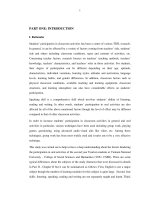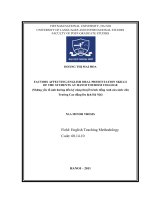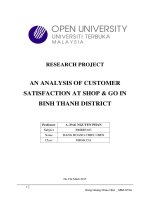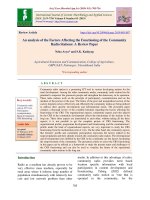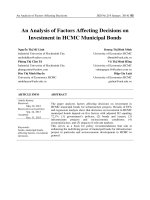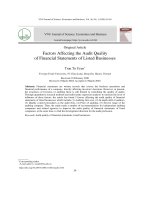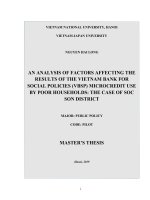8 AN ANALYSIS OF FACTORS AFFECTING THE TRANSLATION QUALITY OF SALE CONTRACTS AT JS HITECH VINA COMPANY
Bạn đang xem bản rút gọn của tài liệu. Xem và tải ngay bản đầy đủ của tài liệu tại đây (333.4 KB, 52 trang )
MINISTRY OF FINANCE
ACADEMY OF FINANCE
-----⧫-----⧫
Student: Đào Phương Thảo
Group: CQ55/51.05
GRADUATION THESIS
TOPIC:
“AN ANALYSIS OF FACTORS AFFECTING
THE TRANSLATION QUALITY OF SALE
CONTRACTS AT JS HITECH VINA
COMPANY”
Major:
Student code:
Supervisor:
English for Finance and Accounting
17522202010158
Bùi Thị Tuyết Mai (Ms.)
Hanoi – 2021
Academy Of Finance
Đào Phương Thảo-CQ55/51.05
Graduation Thesis
I
Academy Of Finance
Graduation Thesis
DECLARATION
I, Dao Phuong Thao, declare that this thesis and the study presented in it are
my own work. Where other sources of information have been used, they have been
acknowledged.
Thesis “An analysis of factors affecting the translation quality of sale
contracts at JS HITECH VINA company”
Hanoi, May 24th 2021
Student
Đào Phương Thảo
Đào Phương Thảo-CQ55/51.05
I
Academy Of Finance
Graduation Thesis
ABSTRACT
This thesis examines the factors that influence the quality of sales contract
translations at JS HITECH VINA company. The main objective of this study is to
find out the pros and cons in the activity of translating sale contract, then finding
ways to develop strengths and overcome weaknesses in the process of translating
contracts. To achieve these goals, this study synthesizes the activities of translating
sale contract at JS HITECH VINA company and analyzes its effectiveness. The
thesis has practical implications in improving the translation quality of the sale
contract at JS HITECH VINA company.
Đào Phương Thảo-CQ55/51.05
I
Academy Of Finance
Graduation Thesis
ACKNOWLEDGMENTS
This thesis would not have been possible without the support of many
people.
First of all, I would like to express my special appreciation and thanks to my
supervisor MA. Bui Thi Tuyet Mai - lecturer of Academy of Finance, for her
tremendous mentor, excellent guidance, caring, patience.
Secondly, I would also like to thank the accounting department staffs in JS
HITECH VINA company esspecially Ms. Dao Thi Tra My who helped me to
conduct data for the study.
Last but not least, I would like to state my special thanks to the staffs of JS
HITECH VINA for their valuable supports during the internship.
Đào Phương Thảo-CQ55/51.05
I
Academy Of Finance
Graduation Thesis
LIST OF ABBREVIATIONS
1. SL-Source language
2. TL-Target language
3. JS company - JS HITECH VINA Co., Ltd
4. QC- Quality Control
Đào Phương Thảo-CQ55/51.05
I
Academy Of Finance
Graduation Thesis
LIST OF FIGURES AND TABLES
List
Figure 1.1 is the structure of the JS HITECH VINA company
Đào Phương Thảo-CQ55/51.05
Page
17
I
Academy Of Finance
Graduation Thesis
TABLE OF CONTENTS
Đào Phương Thảo-CQ55/51.05
I
Academy Of Finance
Graduation Thesis
INTRODUCTION
1. Rationale of the study
English has now become a global language for business all over the world.
Many organisation around the world use English as a means of communication
from email to contracts. Therefore, having knowledge of English has become vital
for success of any business especially FDI company.
English is the preferred language when business partners do not speak the
same language. It’s time when translation need. Translation makes it easier to
communicate with business partners. In Vietnam, foreign direct investment
companies or import export companies need to translate documents from emails to
contracts to contact or negotiate with partners. Especially, translated contracts will
be the main evidence of the cooperation among partners. So, the translation
qualities of contracts need to be true and clear.
During my training time in JS HITECH VINA company, being aware of the
important of the translation quality of contracts, as well as based on the knowledge
learned at school and practical experience gained I got from the internship, I
decided to choose the topic “An analysis of factors affecting the translation quality
of sale contracts at JS HITECH VINA company”.
2. Aim of the study
This study aims at analyzing factors affecting the translation quality of sale
contracts at JS HITECH VINA company and therefore, to suggest solutions to
improve and strengthen the quality of translated sale contracts at JS HITECH VINA
company.
3. Scope of the study
The study is performed at JS HITECH VINA company, Ba Huyen, Tien Du,
Bac Ninh. It’s the product of long gathering, searching and translating process. The
study based on the data provided by the company from 2017 to 2021.
Đào Phương Thảo-CQ55/51.05
I
Academy Of Finance
Graduation Thesis
4. Methodology of the study
This thesis is carried out with some methods. Several methods are used as
follow:
i)
Document collection: sale contracts, internal documents and
information of the business.
ii)
Method of analyzing, summarizing, synthesizing materials
iii)
Text/document comparison, evaluation and conclusion.
5. Organization of the study
The study is divided into three parts:
i)
Chapter 1 is the literature review. This chapter will provide general
knowledge of translation, sale contract and the essential qualities of a translated sale
contract.
ii)
Chapter 2 is The situation of the translation quality of sale contracts at
JS HITECH VINA company. This chapter will give an overview of the translation
of sale contracts at JS HITECH VINA company and analyze the factors affecting
the translation quality of sale contracts. This chapter also presents some limitations
of translation activities of the company.
iii)
Chapter 3 is Recommendations. This chapter analyses some limitation
of translation activities of JS HITECH VINA company and suggest some solutions.
Then it will present some recommendations.
Đào Phương Thảo-CQ55/51.05
I
Academy Of Finance
Graduation Thesis
CHAPTER 1: LITERATURE REVIEW
1.1. General knowledge of translation
1.1.1. The definition
Translation has been defined in numerous way according to the view of each
writer, translator and reader. However, there are some typical definitions which used
popularly.
Lewis (1958:265) points out that “ "translate" is formed from the Latin
"trans + latus", which means "carried across"”. For Wilss (1982), translation is a
transfer process, which aims at the transformation of written source language text
into an optimally equivalent target language text, and which requires the syntactic,
the semantic and the pragmatic understanding and analytical processing of the
source language. According to Foster (1958:1), translation as the act of transferring
through which the content of a text is transferred from the SL (source language) into
the TL (target language). Besides, Tu Anh (2005) wrote that “Translation is the
transmission of a thought expressed in one language by means of another language.
The language used to express the thought directly is called the source language, and
the language used to translate that thought is called the target language”
Translation, by the dictionary definition, is something that is translated, or
the process of translating something, from one language to another. (Cambridge
English Dictionary). According to the Merriam Webster Dictionary, 1974,
translation consists of changing from one state or form to another, to turn into one’s
own or another’s language. Therefore, translation is basically a change of form.
From all of the definitions above, we can conclude that translation is the
action of designing equivalent “version” in the TL to preserve all the surface and
hidden values of the work in SL.
1.1.2. The process of translating
According to PACTRANZ or Pacific International Translations, almost
translators and translation companies adopt this five-step language translation
Đào Phương Thảo-CQ55/51.05
I
Academy Of Finance
Graduation Thesis
process. The translation activity is the mental demanding task therefore the process
of translating is needed to perform well.
This is the five-step language translation process.
i)
Overview
The first step is to scope out the text that you are going to translate. It’s
important to find out the subject matter and content, how long is the text, it’s
writing style, the various section,… etc .
The translator will typically read or skim read parts of the text to get a feel
for the text. The they will note key concepts or terminology that will need to be
researched, and will decide if any preliminary background reading is needed.
Sometimes the translations for key terms will be researched and resolved before
beginning the translation.
ii)
Initial translation
In this step, the translator will systematically translate the text, about 5 to 10
words at a time. It’s important to choose the appropriate length of the text chunks to
deal. The most ideal text chunk is the text chunk with discrete and complete unit of
meaning. But it’s also don’t have to be too long to remember, the text chunk should
be short enough to be retained in short term memory. Every text chunks which is
over 10 words will be struggle to be memorized and translated.
However, sentences are frequently longer than 10 words so that it’s usually
broken down into shorter units.
Working with chunks that are too short or not discrete meaning units may
produce an unnatural and potentially unclear translations, whereas chunks which are
too long to remember may lead to some misunderstanding meaning or run the risk
of some meaning being missed.
Therefore, the act of separating the sentences into properly text chunks is
essential in the initial translation.
iii)
Revewing the accuracy of the translation.
Đào Phương Thảo-CQ55/51.05
I
Academy Of Finance
Graduation Thesis
After the first draft is completed, the translator will then methodically work
through his/her translation comparing each chunk of text with the original source
text. In this step, the translator’s work is not about translating, but more about
revising segment by segment, ensuring that the translator has made an accurate and
faithful translation of the original document; that they have completely understood
the text and not missed any information; that there have been no omissions, and that
any guidelines given by the customer have been fully complied with. Most
translators will also identify and improve any slightly unnatural or inelegant
wording in this step.
iv)
Clearing the mind
The next step is very simple one – put the translation aside and take a break.
The ideal time for a break is a few hours and overnight. This break time will help
the translator clear their mind to ensure a more effective fifth step.
v)
Final polishing
In this final stage, we know that the translation and editing stages of the text
have been completed, so in the proofreading or correction stage it should not be
necessary to refer to the original text. This final review will focus mainly on the
premise that the translated text sounds natural and reads smoothly in the target
language, in addition to detecting any inconsistencies with regard to punctuation
and capitalization. Document formatting must be checked for possible issues
relating to fonts and images, plus the document must be checked for any
typographical errors.
1.1.3. The translation quality assessment.
Translation Quality Assessment has become one of the key issues in
translation studies. For many years, the field of translation evaluation arts has
always attracted domestic and international scholars (Dolet , 1997; Dryden, 1979;
Tytler, 1979; House, 1997; Nord, 1997; Lauscher, 2000; Brunette, 2000; Colina,
2008; William, 2009); previous studies (Wilss, 1996; Schäffer, 1998; Al-Quinai,
2000; Moskal, 2000; Melis & Hurtado, 2001; Mossop, 2007; Williams, 2009;
Đào Phương Thảo-CQ55/51.05
I
Academy Of Finance
Graduation Thesis
Manfredi, 2012; Butler & MeMunn, 2014; Colina, 2015) indicated that the incorrect
assessment of the quality of the translation can have a negative impact to the quality
of the translation and the translator. Derived from the importance of translation
reviews, this section will review some approaches key in translation reviews.
1.1.3.1. Mentalists view
In the pre-linguistic area, the assessment criterias were relatively general and
dependent on the emotional factors as well as intuition of the person evaluating.
Also in translation theory of the West, we can’t ignore the great thesis by Tytler in
the 18th century. He suggested that a good translation should converge all the
important factors including the most important one is “ the quintessence of the
original work is transferred entirely to the target language so that native speakers
reading the translation can understand and feel strongly like the way they
understand and feel the original language. (translation of Ho Dac Tuc, 2012: 61).
1.1.3.2. Dolet, Dryden and Tytler’s views
Translation scholars have discussed the translation quality assessment for
centuries probably because, as practicing translators themselves, they experienced
or observed others experience problems in the process of translation. The scholars
Dolet, Dryden, and Tytler are among the scholars whose statements shed light on
the qualities expected to be present in good translation. These scholars have similar
views on the translation quality assessment.
First of all, the three scholars agree that translators have to understand the
meaning of the original text fully so that they can render what the author says into
the target language. It means that the translator must not only have a complete
command of writing in the target language (the translator's native language, in
almost all cases), but also must be able to perceive stylistic touches and understand
their meaning in the original text. Dolet says that “if the author is at all ambiguous,
the translator can easily make him clear and intelligible” (95) implying the
translator’s right to play with the text by following certain practices like changing
the word order or adding a few words that are originally not in the text. Tytler has
Đào Phương Thảo-CQ55/51.05
I
Academy Of Finance
Graduation Thesis
the same opinions. He firmly believes that translators need to give their decision
based on the general meaning of the whole text and the author’s “usual mode of
thinking” (210). As a result, the translator will not be only reading and translating
the words that follow but also taking the necessary steps in order to be faithful to
the original meaning. Through this practice, the translator can be able to render the
ideas and feelings present in the text written by the author. Since “the sense of an
author, generally speaking, is to be sacred and inviolable” (Dryden: 174), the
translator, these scholars assert, need to pay attention to the meaning obviously
more than they should to the number of words in the original text.
Secondly, the harmony of words is also significant in translation. Dolet
claims that giving the meaning of the text through words that do not have any
rhetorical harmony would not be a good example of a translated text.
Another rule stressed by Dolet, Dryden, and Tytler is the importance of the
style of the author. Dryden states that he aimed to translate Virgil imagining how the
author would have written in the 17th century English, which shows how crucial it
is for him to stick to the style of the original text in its translated version. Tytler also
adds the necessity of maintaining the “style and manner” of the author’s writing in
the translation to his three “laws of translation” (209). However, this task may prove
to be hard for some translators because they may fall into the trap of being too
faithful to the original. As a result, the text may not have “the ease of original
composition” any more (Tytler: 211). Since the task has its own difficulties, it does
not look wise to make it even more difficult or maybe impossible by attempting to
translate word by word, which already contradicts with the above mentioned rules.
1.1.3.3. Basic views
There are some general principles of translation quality that are relevant to
all types of translations:
i)
Meaning
Be faithful to the original text. Nothing should be arbitrarily added or
removed, though occsionally part of the meaning can be transposed. Don’t try to
Đào Phương Thảo-CQ55/51.05
I
Academy Of Finance
Graduation Thesis
find the exact word in translation language for the word used in the language being
translated. It may lead to some misunderstanding and confuse the reader. If you can
invent a word, or use the original word and explain its meaning in a footnote.
ii)
Form
The ordering of words and ideas in the translation should match the original
as closely as possible. This is particularly important in translating legal documents,
guarantees, contracts, etc. But differnces in language structure often require changes
in the form and order of words. When in doubt, underline in the original text the
words on which the main stress falls.
iii)
Source language influence
One of the most frequent criticism of translation is that it does not sound
natural. This is because the translator's thoughts and choice of words are too
strongly moulded by the original text. In the majority of cases, it shouldn’t be
overshadowed or influenced by the original language, or retain characteristics of the
original language, unless they coincide, or it’s appropriate to do so. A good way of
shaking off the source language influence is to set the text aside and translate a few
sentences aloud, from memory. This will suggest natural patterns of thought in the
first language, which may not come to mind when the eye is fixed on the source
language text.
iv)
Style and clarity
The translator should not change the style of the original. But if the text is
sloppily written, or full of tedious repetitions, the translator may, for the reader's
sake, correct the defects. Keep the tone of the original work in mind. If it is lighthearted, the tone of your translation should also be light-hearted (which is not
always easy. Some people are so literal that they take satire for genuine news).
1.1.4. Influencing factors of translation quality
1.1.4.1.
The quality of the source text.
The translation’s meaning must be faithful to the source document, therefore,
the quality of the translation mainly based on the quality of the source text. The
Đào Phương Thảo-CQ55/51.05
I
Academy Of Finance
Graduation Thesis
source document should be written in a way that the translator can understand fully
and don’t have to guess what anything means. The fact that the translation can only
be as good as the source document so that any errors, omissions, inconsistent
terminology or vague wording of source text can affect the translation quality.
Therefore, we only can have a good translation if it’s source text have been
adequated already.
1.1.4.2.
The experiences and knowledge of the translator
The translator plays an important role in creating a good translation. Every
sectors has its own knowledge and vocabulary so that it’s necessary to choose a
translator with experience and a specialization in the sector of the text for
translation. The translator that is familiar with the text’s particular subject matter or
type will know which sources are most suitable for researching terminology within
the area and the right form to perform. For example, a translator specialized in
fashion texts would not know the specific terms and concepts that are common in
agriculture translations. In some cases, translators also receive documents which
are not their major, but the quality of these translation will be not as good as their
translations of their specialized sector.
1.1.4.3.
Planning
The quality can’t be rushed. A translation can only form well when the
translator plan the timeline and have enough time for the translation process.
Average reading speed is 200 words per minute, and writing speed is on average 38
words per minute. But translating is not about just reading and writing. The
translators have to come up with an appropriate translation of the word or phrase
and also pay attention to grammar, style and terminology. They have to look things
up in dictionaries and other resources. Then they have to go over the translation a
couple of times again for fine-tuning, etc. At this situation, high paid will not
miraculously increase translation speed. If the translator is forced to work in a rush,
the quality of the translation would be affected negatively because the translator
Đào Phương Thảo-CQ55/51.05
I
Academy Of Finance
Graduation Thesis
can’t focus on the details. There is no document which is translated immediately, if
there, it's certainly translated by the machine.
1.1.4.4.
The final editing
The last phase of the translation process plays an important role in ensuring
the translation’s quality. In this phase, the translation will be review once or twice
and the translator will fix all the error or inconsistent terminology. Besides, all the
references and cites should be added in this step. Therefore, this final editing phase
should be done in a careful way.
1.2.
General knowledge of sale contract.
1.2.1. The definition of sale contract
According to The Cambridge Dictionary, they define “ contract” as “ a legal
document that states and explains a formal agreement between two different people
or groups, or the agreement itself”.
Legal Match states that “an agreement between two private parties that
creates mutual legal obligations. A contract can be either oral or written”.
There are many types of contract including sale contract.
According to the First Foundation, the definition of sale contract is that “A
sale contract is a written agreement between a buyer and seller of real estate, setting
forth the terms of the sale, and specifying the rights and duties of the parties in the
real estate transaction. It will be signed by the buyer and seller and their witnesses
and will become legally binding upon each party”.
For example, Mr. McGillicuddy wishes to sell property to Mrs Danforth.
After agreeing on a price, closing date, and other terms of the sale, Mr.
McGillicuddy’s attorney prepares a sale contract. It is reviewed and signed by Mr.
McGillicuddy and Mrs Danforth. The parties are now legally bound by the terms of
the contract and it will govern the sale transaction.
A sale contract is the basis of the real estate transaction, it is in large part the
“law” the parties agree to bind themselves to. In the event of a dispute in the future,
the terms of the real estate will control and define the dispute.
Đào Phương Thảo-CQ55/51.05
I
Academy Of Finance
Graduation Thesis
According to Upcounsel, the definition of sale contract is that “A contract of
sale is an agreement between a seller and a buyer. The seller agrees to deliver or sell
something to a buyer for a set price that the buyer has agreed to pay. With these
contracts, the transfer of ownership happens when the buyer pays and the seller
delivers.”
1.2.2. Characteristics of sale contract.
1.2.2.1.
Characteristics.
According to the Project Jurisprudence, the sale contract has 6 main
characteristic:
i)
“A contract of sale is consensual because the contract is perfected by
mere consent. This is different from a real contract (perfected by delivery). Paras
(2008) explains that a real contract is one perfected by delivery and he gives, as
example, a contract of deposit or commodatum. In a real contract, the agreement
does not start to operate unless the thing or the person (over and/or for which the
contract is made) is placed in the control of one of the parties. Therefore, being
consensual, a contract of sale does not require delivery of the thing sold/bought.
Such delivery is merely an obligation on the part of the seller (vendor), which he
must perform right after perfection, after delivery to him of the purchase price, after
a period or after the happening of a condition, etc.”
ii)
“According to Paras, a contract of sale is a bilateral reciprocal
contract because both parties are bound by obligations dependent upon each other.
In other words, it is bilateral because both parties are obliged to perform an
obligation (the seller delivers; the buyer pays). It is reciprocal because the one
party's obligation becomes demandable the moment the other party performs his
obligation.
Therefore, the moment the seller places the buyer in possession of the thing
due, the latter, absent any stipulation to the contrary, should deliver the purchase
price to the former. The same is true vice versa.”
Đào Phương Thảo-CQ55/51.05
I
Academy Of Finance
iii)
Graduation Thesis
“ A contract of sale is onerous because, to acquire the rights, valuable
consideration must be given. Cause or consideration is a general requirement for the
existence of contract. What is referred to here is valuable consideration (in
pecuniary terms). Compare a contract of sale with a deed of donation; the latter does
not require, as a rule, a valuable consideration from the donee”
iv)
“ A contract of sale is commutative, as a rule, because the values
exchanged are almost equivalent to each other. This is the presumption because, in a
normal contract of sale, the seller sells and the buyer buys at a price at which both
of them are willing to sell and buy. Generally, when persons buy something, they
think that what they get is equivalent in value to the money they have to pay.”
v)
A contract of sale is principal because for it to validly exist, there is no
necessity for it to depend upon the existence of another valid contract. In other
words, it is principal because it can exist independently.
vi)
A contract of sale is nominate because the New Civil Code of the
Philippines refers to it by a special designation or name, i.e., the contract of sale.
There are contracts not mentioned in the Code such a contract where a person lets
another live in his house in exchange of a daily back massage. These contracts not
specifically or specially named by the Code are called innominate contracts.
1.2.2.2.
Elements of contract of sale.
When writing or reviewing or translating a sales agreement, it is important to
know what things must be included and which terms are most important to be
included in a sales contract.
i)
Parties
An essential element of a contract of sale is that there must be two parties to
the contract of sale viz., seller and buyer. In a contract of sale, the ownership of
goods has to pass from one person to another. Hence the seller and the buyer must
be different persons because one person cannot be both the buyer and the seller.
ii)
Description of goods.
Đào Phương Thảo-CQ55/51.05
I
Academy Of Finance
Graduation Thesis
It is very important to mention a detailed and vivid description of goods in
the sales contract. Otherwise, later the seller can get into trouble because of the
errors in the description of goods. Make sure that the description should be of exact
goods that a buyer wants to buy in the future. The contract should include details
such as model number, type, color, weight, and size.
Mentioning all these details accurately will ensure that the seller will deliver
the buyer correct product. In the failure of getting the correct goods, buyer can take
legal actions on the basis of the sales contract. However, all other problems with the
agreement can be neglected as long as the buyer is getting the products that he has
asked for.
iii)
Delivery instruction
Late delivery, delivery at wrong address or careless delivery can cause
problems and can disrupt the production or sales process. therefore, it is very
important to mention the correct date, time and place of delivery of goods clearly. In
addition to this, the sales contract should also mention who will be responsible for
the loss of goods or any other mishappening.
iv)
Inspection period
“Inspection period” is one section that most buyers forget to include in a
sales contract. This period will give time to the buyer to inspect the goods deliver to
them and reject any different goods. However, the inspection time is different for
different types of goods. For example, goods which have a short shelf life
(perishable goods) are required to accept or reject immediately.
However, expensive goods such as machines a buyer requires a little longer
time (for a week or a month) to inspect goods and take the decision of accepting or
rejecting goods.
v)
Warranties and guarantees from the seller
It is common to neglect the warranties set by the seller for the goods.
However, neglecting warranties can be risky as no one can predict how a thing will
Đào Phương Thảo-CQ55/51.05
I
Academy Of Finance
Graduation Thesis
come out in the future. besides this, there is no standard format for warranties on
goods and it varies from industry to industry and company to company.
vi)
Payment details.
This is the most important part after the description of goods in a sales
contract. Mentioning the total price of goods is important. However, it is also
important to mention all other payment details to avoid any type of confusion in the
future. the payment details should include whether the payment will be made in
installments or single transaction, will buyer have specific criteria to get paid.
In addition to this, in case if the buyer is not paying the right way then it is
wise to include a promising note or have a separate promising notes to mention
payment terms in more detail. In the note, you can also mention whether the interest
will be incurred by the seller or not for the delay in the payment.
1.3.
Essential qualities of a translated sale contract in a company
A sales agreement between two businesses or a business and an individual
customer can ensure proper execution of any contract even if both parties are solidly
committed to the deal. A sales agreement can prevent miscommunications that can
damage relationships or put the company in a financial bind, and it will help
company better manage finances and business relationships. Because legal
translation is culture-dependent, it’s necessary for a company to get a or some
translators to translate sale contract if they want to expand their operations and trade
with foreign companies. That’s the reason why the translation of sale contract in a
company must have some characteristics.
1.3.1. Inner qualities
1.3.1.1.
Accuracy
Accuracy is therefore very important in translating these documents to
ensure that no ambiguous and vague interpretation of these documents occurs. As
legal disputes arising from poorly translated documents can be costly, it would even
be far too damaging for the business to manage.
1.3.1.2.
Outer qualities
Đào Phương Thảo-CQ55/51.05
I
Academy Of Finance
Graduation Thesis
Apart from meaning, the form of translation of sale contract must be similar
to the source contract. The translation version should have enough elements of the
source contract such as parties, description of goods or payment…
In addition, legal contract is culture dependent, the translations must be
consistent with the culture and the legal language to which it is translated. Such
translation should be precise and accurate, and reflect coherent connection between
the translated language and the source language. Furthermore, the translator must
retain the legal system of the source text from which the translation is derived
CHAPTER 2: THE SITUATION OF THE TRANSLATION QUALITY OF
SALE CONTRACT AT JS HITECH VINA COMPANY
2.1. General information of JS HITECH VINA company
2.1.1. Brief introduction of JS HITECH VINA company
Company name: JS HITECH VINA COMPANY LIMITED
Headquater: Ba Huyen street, route 38 (renting factory Phuoc An Co.,Ltd)
Khac Niem ward, Bac Ninh province, Viet Nam.
Phone number: 0222.6277.333
Fax: +74 86 4780 2365
Email:
Website: />Tax Identification Number: 2300889400
Slogan: Your effort, our future
Established on 08/06/2015.
JS HITECH VINA Co.,Ltd is 100% foreign-invested one member company
limited, established under:
The Investement Certificate No 3261151454 issued by Bac Ninh Department
of Planning and Investment for the first time on 2 June October 2015, adjusted the
second time on 3 June 2016, and Business Registration Certificate number
2300889400 issued Bac Ninh Department of Planning and Investmnet for the first
Đào Phương Thảo-CQ55/51.05
I
Academy Of Finance
Graduation Thesis
time on 2th June 2015, adjusted the second time on 21th April 2016. The investor is
JS HITECH Company Limited in Korea.
JS Company is also an economic cooperation between Vietnam and Korea.
With the development of the wave of foreign investment in Vietnam, JS company
also quickly caught up and developed strongly. After 6 years of development, the
company has been and is a leading company in Vietnam-Korea cooperation
companies and a tier 1 vendor of a number of large corporations.
JS HITECH VINA company is formed by a group of experienced and
professional people. It’s slogan is “Your effort, our future”. JS company is strongly
developed thanks to the clear leadership and strong efforts of all employees and
workers. The efforts of leaders, employees, and workers will create a better JS
company in the future.
2.1.2. Business areas
Manufacture of measuring, testing, navigating and control equipment.
Details: Manufacturing and assembling machines that have the function of
checking the quality of devices, spare parts and parts of telephones, fans, and
computers.
Main products: JIG. For example, the company manufactures some machines
such as CNC 8EA, Wire cutting machine 1EA, E200A automatic machine 2EA,
Drill 2EA,
The investment captial of the company is USD 1.200.000 equivalent to VNĐ
26.361.546.646.
The charter capital contributed as at 31 December 2020 is USD 200.000
equivalent to VND 4.349.653.970
The company is a leader in the production and assembly of machines with
the function of checking the quality of equipment, spare parts and parts of phones,
fans, and computers. In addition, the company is also a reputable unit in receiving
repair and installation of industrial equipment.
Đào Phương Thảo-CQ55/51.05
I
Academy Of Finance
Graduation Thesis
JS company is also the tier 1 vendor of some large corporations such as
LGD, LGE, Serveone, SEV, SEVT, SDV.
Main activities:
a)
Manufacturing and assembling machines that have the function of
checking the quality of devices, spare parts and parts of telephones, fans, and
computers.
b)
Repairing, assembling machines or spare parts according to the
clients’s orders.
c)
Providing machines that have the function of checking the quality of
devices, spare parts and parts of telephones, fans, and computers to partners.
d)
Importing and exporting the product
e)
Purchasing the raw materials.
Main markets: Vietnam, China, Korea, India,…
2.1.3. Structure of the company
In 2020, the company does not have any subsidiary, associate, joint ventrue
or any independent unit which does not constitute a legal entity.
Figure 1.1 is the structure of the JS HITECH VINA company
Đào Phương Thảo-CQ55/51.05
I
